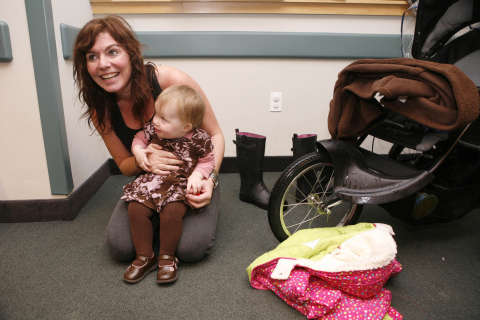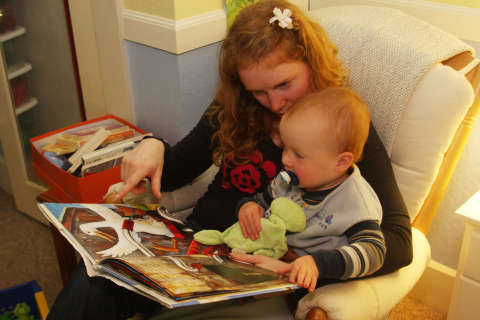The search for affordable, convenient, quality child care is a struggle in the Washington region. The five-part series Child Care Crisis will look at why it’s so hard to find care, and why costs are surpassing college tuition rates. The reports also examine the emotional toll the lack of child care takes on families.
WASHINGTON — The picture of the American family has changed dramatically in the last 50 years, but public policy has struggled to keep up.
The U.S. does not have universal paid maternity leave and is the only country among 41 nations that does not offer paid parental leave. And while more companies are implementing flexible work schedules, it isn’t the norm.
What it’s leading to is an incalculable amount of stress from those trying to balance it all.
“When I had three kids under age 5, I remember thinking that I would rather have my husband leave me than my baby sitter,” said Leslie Morgan Steiner, who writes on parenting and issues facing American women today.
The fifth and final report of the Child Care Crisis series explores potential solutions to decrease the burden of child care on American families.
‘The system really stresses American families’
Just two blocks from the White House, Brigid Schulte and her colleagues at New America’s Better Life Lab study society’s most complex and constantly evolving topics: gender norms and family policy. Child care is at the forefront of their work.
Schulte, co-author of The Care Report, said the current child care system is a patchwork, a collection of fragmented pieces, and it’s not working.
“What we see is that the system really stresses American families, not only financially, but in terms of time, in terms of bandwidth, in terms of anxiety and worry,” she said.
Schulte, who is also a mother, had three different caregivers at one point because she couldn’t find anything else that worked to cover the gaps between her work schedule, her husband’s work schedule and her kids’ school schedules.
“And that’s a really common experience,” she said. “Parents in countries where there are supports, where it’s not so difficult to be a parent and work and raise a family, they’re not only happier, but they’re more productive.”
Much of the reason for that productivity and happiness, Schulte said, is because there’s an established model for child care in those countries. In France, for example, children from two-and-a-half months to 3 years old can be placed in a crèche, or a child care center that is funded by the government. Parents pay a fee based on their income.
“We’re falling behind. Other countries, especially western, advanced economies long ago made the decision that early care and learning was not just a workforce support to help working families, but really something that was an investment in the future,” Schulte said.
Both Steiner and Schulte said that similar to fire stations, libraries and public schools, child care should be considered a public good.
“It’s that critical to the future of our country — having kids who are well-cared for and are socialized and get a good education from the very beginning, because day care in many ways is about education, even if it’s as simple as learning to share or learning to trust other people besides your parents,” Steiner said.
The good news is, there is already a framework in place: the public school system. Schulte said school arbitrarily starts at 5, and there’s no reason that needs to remain the rule.
More states are offering pre-Kindergarten education, including D.C., which extends early learning to 3-year-olds. Schulte said she would like to continue to see programs such as D.C.’s universal pre-K program include even younger ages.
“We just need to back that up to 0 to 3,” she said.
Of course, expanding government-subsidized early education to the country’s infants and toddlers will require a big investment. But Schulte said it’s an investment that will pay off.
“Having a functioning, high-quality system is actually not just morally right and a good thing to do, but actually it’s great for business,” she said.
Waiting to invest in early childhood education until a child is 3 or 4 is too late, according to research from University of Chicago economics professor and Nobel Laureate James Heckman. Starting early guarantees a return on investment. For at-risk children, Heckman found the return was an estimated $7 for every $1 invested in early care and education.
“The difficulty is, we as humans tend to make decisions that we can only see in the short-time horizon. Investing in child care is investing in the long-term, and it really does pay off in the end. … Child care really should be part of the infrastructure bill that they’re talking about; this is part of the infrastructure that we need to build in this country,” Schulte said.
When work makes it work
In the absence of a universal child care system, some companies are taking matters into their own hands to make the work-life balance easier on their employees.
Netflix recently announced paid unlimited time off for a year to new parents. Facebook and Microsoft offer generous paid maternity and paternity leave policies. Some companies even host on-site day care centers where employees can send their children for a lower price than most private centers.
“In particular with parents, we find that especially millennial employees are looking to spend more time with their children … it’s really important to employees to find the time to take care of responsibilities both on and off the job,” said Cassidy Solis, program specialist at the Society for Human Resource Management.
For employers who have a population of parents or prospective parents, it’s especially important to promote family-friendly policies in the office.
“If an employee is worried that their child is not being taken care of in a safe, quality, happy environment, they’re not going to be productive; they’re going to be out a lot caring for that child, which could then impact other employees,” Solis said.
“So this kind of system in place that helps these employees is really great for everyone. It’s great for the organization, it’s great for the working parents and it’s great for their co-workers.”
Building an on-site child care center, however, is not an easy feat. Solis estimates only 2 percent of companies adopt this model. It requires a lot of research, a lot of resources and a lot of money.
Fortune reports a 10,000-square-foot on-site center that can handle 100 kids might cost $1.7 million to $2 million to build.
Patagonia’s CEO Rose Marcario offers on-site child care for employees, and estimates it costs the company $1 million per year, even after parents pay their fees, Romper reports. Bon Secours Health System, based in Richmond, Virginia, however, finds that the investment pays off.
“The interesting thing is they actually measured this retention aspect and have found that working parents who utilize their on-site child care centers have a higher retention rate,” Solis said.
“It’s one of these models that helps employers help their employees,” she said. “But then, in return, it produces these highly engaged, highly loyal, very productive employees, and it’s really a win-win for everyone.”
Smaller companies are also finding ways to help employees balance parenthood and professional life. At Badger, a family-owned company that makes organic body products, new parents can bring their babies to work with them for the first six months of life. They are paid a reduced salary, since it’s understood that a portion of their time at work will be spent tending to their child, but Solis said it’s been well-received.
“They really set out as a culture within their organization as ‘family first’ and they wanted to implement a program that would allow their employees to both remain employed with them but also embrace this unique and special time of life,” she said.
Not every business can have children on site, but Solis said they can give employees support in other ways. The most popular is with flexible schedules.
“This trend toward empowering employees to accomplish their work goals in a way that works for them, I absolutely see increasing,” Solis said.
“These programs in place that help parents choose how to best care for their kids, whether that’s workplace flexibility, teleworking, or in the rare case a (work-based) child care center, this is great for, not only the parents, but the whole organization.”








